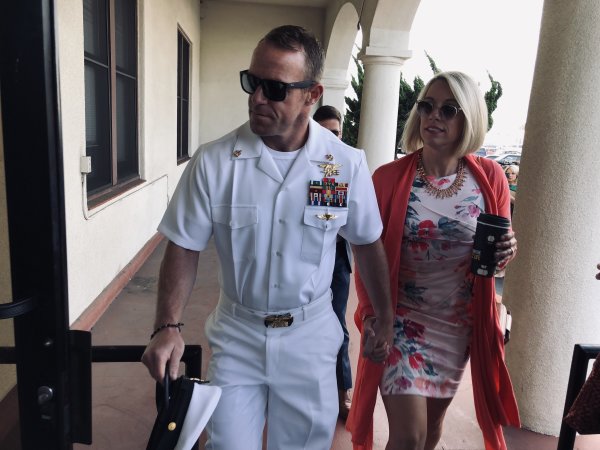

NAVAL BASE SAN DIEGO — The military judge in the war crimes trial of Navy Chief Eddie Gallagher said that some witnesses offered “inconsistent” testimony, but it was solely up to the jury to “determine the believability” as they deliberate over whether the veteran SEAL murdered a wounded ISIS fighter or shot at innocent civilians in Iraq in 2017.
Both sides in the case presented their closing arguments before a jury of five Marines and two sailors on Monday. They will now decide Gallagher’s fate after nearly two weeks of testimony.
Prosecutors painted a picture of a man, proud of his kill, who sent a “trophy photo” of the murdered detainee to friends, while the defense argued that the government and NCIS agents had a “target fixation” on Gallagher that led them to not ask important questions or consider alternatives.
“There are huge gaping holes of reasonable doubt,” defense attorney Tim Parlatore said.
Before he spoke, Cmdr. Jeffrey Pietrzyk put up a slide on the screen behind him with a text Gallagher had sent to a friend: “Good story behind this. Got him with my hunting knife,” Gallagher texted, along with a picture of himself holding a knife next to the ISIS fighter’s head.
“Those are his words,” Pietrzyk said. The prosecutor added that numerous SEALs had reported him — “his SEALs,” he said, pointing at Gallagher — and the jury had photos and video evidence, along with the chief’s own words, written in private text messages.
“We know because Chief Gallagher said so,” Pietrzyk said. “Got him with my hunting knife.”
Pietrzyk acknowledged that a wounded ISIS fighter wouldn’t get much sympathy from the jury or anyone else. “I’m not going to argue to you that this was a particularly sympathetic victim,” he said. Before he was hit by a U.S. air strike, Pietrzyk said, “he would’ve done anything in his power to kill Americans.”
But, Pietrzyk said, he was no longer fighting, and receiving medical care. “At that point, he was no longer a lawful target,” he said. “We’re not ISIS. When we capture someone they’re out of the fight. That’s it.”
In laying out the government’s case, Pietrzyk mentioned other SEALs had testified that Gallagher had fired on innocent civilians from a sniper tower. He went on to say that Gallagher had tried to obstruct justice and retaliate against those who reported on him by threatening that he “had shit on all of them.”
Some of the witnesses in the case had “straight out lied to you,” Pietryzk told the jury, while some had told partial truths and others had risked it all and told them everything.
“Did they choose the truth, or did they choose loyalty to Chief Gallagher?” Pietryzk asked, then putting up the picture of Gallagher posing with the dead ISIS fighter.
“They say a picture is worth a thousand words. These are worth one: Guilty, of all specifications and charges.”
The closing from the defense side started off much like its opening statement, with defense attorney Tim Parlatore asserting that “this case is not about a murder. It’s about a mutiny.”
Parlatore said it was only a few “young entitled” members of the SEAL platoon who hated Gallagher that reported him for war crimes. Parlatore said those SEALs had taken part in a mutiny and conspired in a text message “sewing circle” to get back at him for stealing items from them and putting them at unnecessary risk on the battlefield.
“When the chief pushed them, they didn’t like it,” Parlatore said.
Gallagher is charged with two counts of attempted premeditated murder in separate incidents of using a sniper rifle to target noncombatants. Of the first, involving an old man, Parlatore said there was “no credible evidence” the killing was unlawful, since government witnesses testified they had fired warning shots without telling Gallagher, who then fired and said over the radio, “you guys missed him, but I got him.”
The second alleged shooting, of a young girl which only one SEAL witnessed, Parlatore speculated that a girl weighing between 80 to 90 pounds being shot by a .300 Win Mag round would’ve done far more damage. Special Operator 1st Class Joshua Vriens said he noticed the girl clutched her stomach and was dragged away by others.
“It doesn’t make any sense,” Parlatore said. “These charges should never have been presented to you.”
Parlatore also argued that if Gallagher had indeed stabbed the ISIS fighter in the neck, there would’ve been blood everywhere, to include on his hands, uniform, boots, and the knife.
“Stabbing somebody in the neck is a very messy endeavor,” Parlatore said. “The terrorist did die but Eddie Gallagher did not kill him.”
Defense attorney Marc Mukasey took the second half of the closing argument, attacking the investigation itself and the actions of the lead agent, Joseph Warpinski. As Mukasey mentioned, Warpinski admitted in testimony that he had made mistakes.
“In a case this serious, when someone’s life is on the line,” Mukasey said. “You can’t tolerate mistakes.”
Mukasey reiterated the judge’s instructions to the jury — that the government had the burden of proving the charges beyond a reasonable doubt, but they had failed.
“They have failed in an epic way to prove the cause of death, forget Chief Gallagher,” Mukasey said, as a slide appeared on screen showing other possibilities: Hellfire missiles, blast lung, internal injuries, and treatment from the Iraqi Emergency Response Division.
“Reasonable alternatives offer reasonable doubt,” Mukasey said. He told the jury they were the “guardians of justice” and asked them to “deliver the verdict that gives Chief Gallagher his liberty.”
The jury began deliberation on Monday afternoon. They’ll decide whether to convict Gallagher on charges of premeditated murder, attempted premeditated murder, obstruction of justice, and others. At least five, or two-thirds of the jury, are needed to convict.